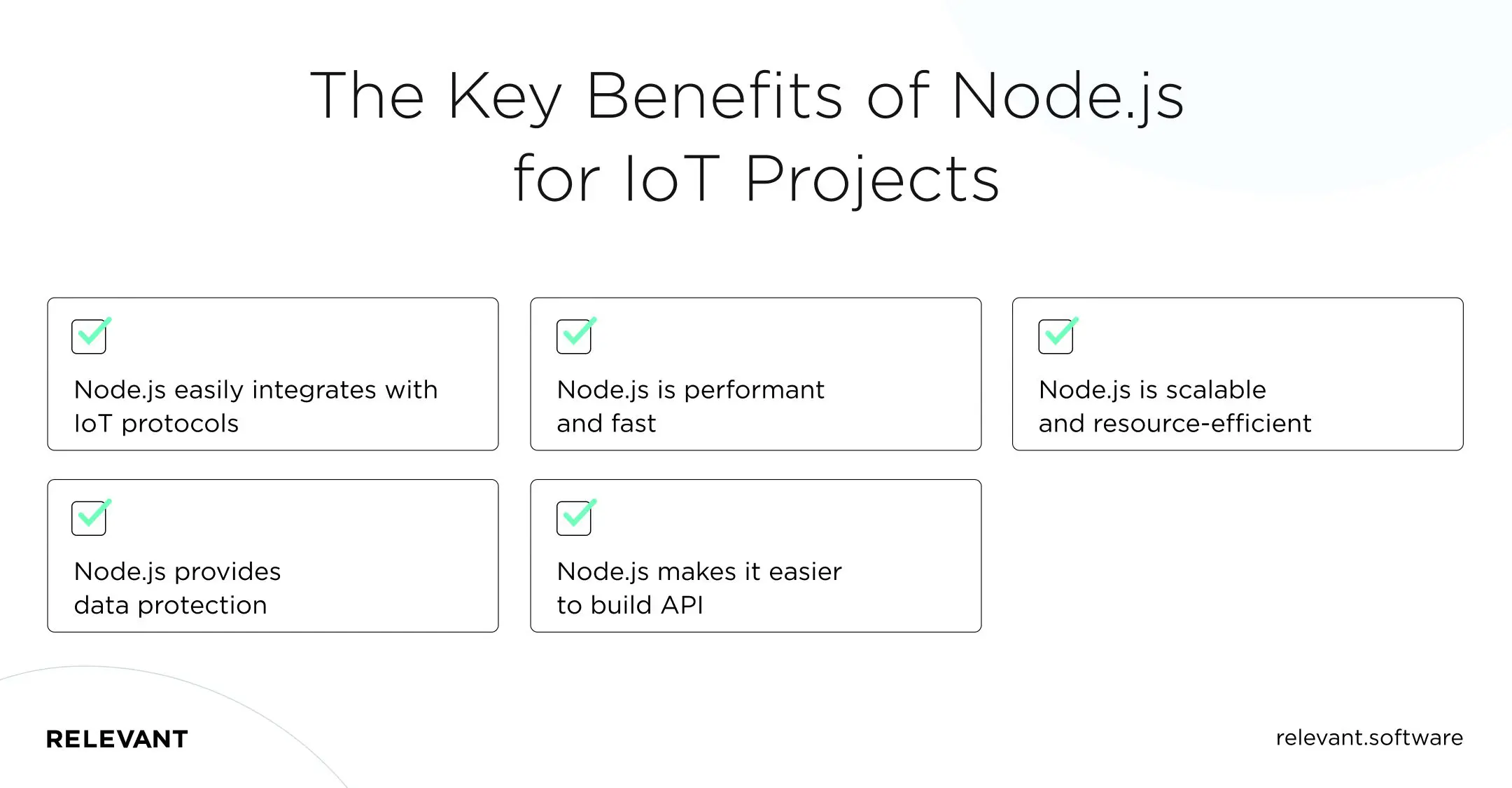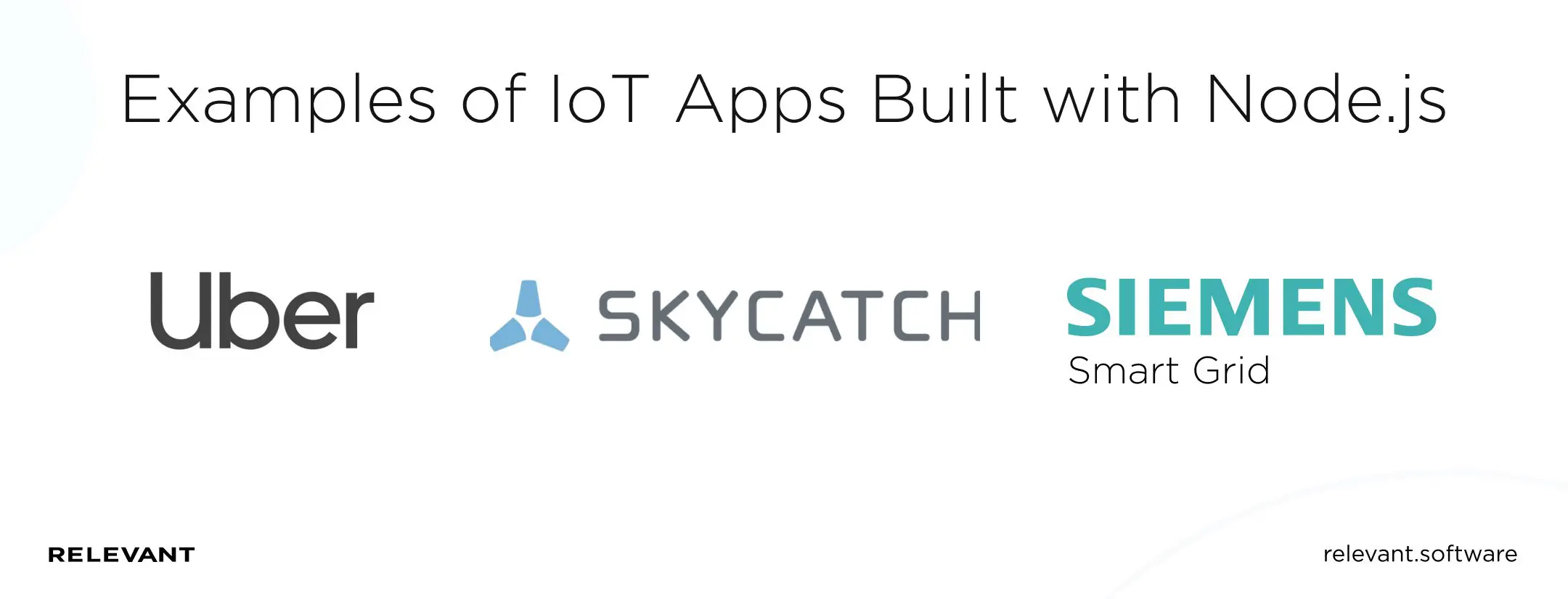Should You Use Node.js for Your IoT Development Project?

The Internet of Things is a future that is already here. Today, over 50% of companies incorporate the Internet of Things into product delivery or development. And to manage related devices, sensors, and equipment, each of which comes with its interface, you need a unified IoT software that can handle bulk data.
We should note that a reasonably extensive selection of programming languages is available to developers to create such solutions. Java, Python, C ++, Ruby are widely used for IoT software development and do an excellent job with this task.
But as regards languages designed especially for this kind of development, none of them compare to JavaScript. Despite some shortcomings, it’s more than excellent for developing IoT applications.
There are good reasons why Relevant programmers favor Node.js as a runtime environment for IoT mobile apps. We walk you through the IoT and Node.js benefits and clarify why this is the best synergy for your future IoT projects.
IoT market – where do we stand now?
Despite the pandemic, the IoT market keeps growing, so does the spending on IoT. According to the latest IoT Analytics report, in 2020, IoT hardware spending increased 5.4%, enterprise IoT solutions spending grew 12.1%, and IoT cloud infrastructure services spending rose 34.7% over the same period.

After 2021, analysts project IoT spending to grow 26.7% annually. And the number of global connections to the Internet of Things is expected to reach 27,1 billion in 2025.
The decisive factors for this growth are:
- The constant evolution of the computing power of cloud computing;
- Development of new methods for processing big data;
- Implementation of IT security standards for the IoT ecosystem;
- Extensive use of APIs for integration capabilities;
- IoT cloud platforms availability.
Why choose Node.js for IoT development?
Before looking at the performing Node.js in the IoT, we will briefly recap how it works. The IoT is physical objects with embedded sensors, software, and other wireless technologies synchronized and connected to the network. Systems collect, track, and exchange changing data with other devices, and the IoT platform is an intermediary in this process.
The framework must cope with streams of data in real-time while maintaining the pace. In addition, IoT platforms handle data visualization processing and ongoing management tasks that enable users to automate their environment.
Even though many technologies are used to develop smart connected systems, the framework plays a crucial role. Since this area is actively developing, there is no final winner yet. But most software developers and hosting companies think Node.js development is most reliable for IoT projects. And we’ll explain why. So what are the advantages of Node.js?
What are the exact benefits of Node.js for IoT?
To begin with, Node.js is an open-source and cross-platform runtime environment used by enterprises of various sizes to develop fast and scalable apps. It is a high-performance tool that programmers willingly use for different projects.
Node.js also boasts a vast community of developers, many IoT libraries, and the ability to work stably on projects without taking up a lot of server resources. Here are the causes to choose Node.js development for IoT platforms and apps.
Node.js easily integrates with IoT protocols
Integration is one factor on which the Internet of Things largely depends. Node.js supports the MQTT protocol, commonly used by IoT apps, making it easy to connect to independent and third-party services and prepare it for integration through multiple environments. Integration is done at the back-end level.
All IoT SDKs for Node.js from top cloud providers are built on MQTT.js. AWS IoT Node.js example of such integration. It can safely process and route millions of messages to AWS endpoints and other devices using MQTT.
Node.js is performant and fast
As mentioned, any IoT device works with briskly changing data. Therefore, it needs a robust IoT platform that will handle large data streams in real-time.
Node.js comes with Node Packaged Modules (NPM), which offer advanced repositories to IoT requirements. Equipped with Google’s V8 engines, Node.js compiles JavaScript into native machine code that offers high-speed execution. The NPM repository comprises over 80 packs for the Arduino controller and several packages for the Pebble and Fitbit wearables. It also proposes built-in IoT architectures for Bluetooth devices and sensors.
A flow-based programming tool Node-RED allows you to build IoT applications with low code. The ability to create C ++ modules is very helpful in the IoT world. For much of the hardware, C drivers already exist so that developers can plug them into Node.

Node.js is scalable and resource-efficient
Node.js has a shorter execution time, so it uses fewer resources to run than an app built on, for example, Java or Ruby. For example, a typical 8GB RAM device can handle 4,000 concurrent connections simultaneously, with each thread taking up 2MB of memory. With Node.js, this same device can hold one million simultaneous connections.
Node.js provides data protection
In the IoT, we connect multiple devices to a single network to exchange data for a peculiar task. Proper execution requires interactivity and interconnection between devices. For IoT devices, security has three components:
- Access rights to different functionality;
- Authenticating devices and users;
- Thoroughgoing code architecture.
Node.js can meet these needs.
Secure authentication
There are many authentication tools available for Node.js apps: tokens, auth0, jwt, etc. Each has its pros and cons when viewed from an IoT perspective.
Tokens are efficient, but not completely secure. They are a great way to authenticate, as they allow you to identify a specific user and determine to grant or deny access.
The IoT ecosystem even stores an encrypted token or login/password data in firmware. If there is physical access to the equipment, someone can steal the token, which also applies to jwt or auth0.
You can use any server-side authentication tools by integrating them into the Node.js framework. Node Package Manager allows you to do this manually: passport, auth0, jwt. There are also packages for integrating cloud services, such as Azure IoT hub Node.js or AWS-IoT.
Secure HTTP requests
You can do it manually (It’s pretty simple in Node.js) or use hosting with HTTPS certificates and configuration.
Node.js makes it easier to build API
Another advantage of Node.js is the capacity to create APIs. For example, LinkedIn developers were the first to develop a mobile API by Node.js development tools. The platform integrates Node.js frameworks for building web services and APIs. A Node.js company can quickly create an API since it only takes a few lines of code to write.

What are the examples of IoT apps built with Node.js?
The maturity of the Node.js ecosystem is essential to the Internet of Things. But when to use Node.js.? Here are some real-life examples:
Uber
Uber has been using Node.js to core trip execution engine. The main reason for this choice was the asynchrony, the ability to process big data, clean code, and the affordable cost of its implementation.
The essence of this application is a driver-passenger matching system. It needed an event-driven environment, a short but powerful code, and handling huge loads. And Node.js could offer this. At the moment, Uber can support 2 million real-time calls per second.
Skycatch
Skycatch specializing in drones uses Node.js to take photographs of construction sites and transform them into 3D models needed to launch construction projects. The technology also came in handy for finding areas affected by the earthquake in Nepal.
Siemens Smart Grid
Siemens Smart Grid successfully used Node.js in commercial solutions such as Monet – a robust management product designed to conserve energy and detect anomalies and potential hazards in energy use. Monet uses Node.js as the app tier and MongoDB to store data hosted in the Microsoft Azure cloud.

How can Relevant help you with your IoT software development projects?
Node.js is currently one of the best IoT frameworks that companies can use to handle large bursts of requests generated by IoT sensors and wearables.
But Node is only a tool that is only effective in the right hands. To build an IoT application using this versatile technology, you need the best Node.js IoT developers that we in Relevant have.
- We use Node.js to build innovative software solutions while adhering to IoT security best practices.
- We help leading companies in a variety of industries to implement effective IoT systems.
- Sensor Innovation – an optimized online IoT platform for real-time data alerts and monitoring.
- Airthings – an interactive web-based dashboard for visualizing air quality sensor data.
- We grant support at every stage of the Internet of Thing development services – from prototype to delivery and maintenance.
- We offer a talent pool with extensive experience in UI/ UX, DevOps, Big Data, and much more.
Conclusion
We are rapidly moving into a hyper-connected world. Smart cities and devices, intelligent transport and logistics, personalized healthcare are already a reality that needs software support.
That is why Node.js Internet of Thing development is an up-and-coming move that gives you the edge in the race for digital presence in the marketplace. In addition, building a web solution on Node.js can be one of the most profitable investments in the long term, appropriate for getting started on the road to IoT.
Are you looking to join this thriving market niche and create your custom IoT mobile app or platform? At Relevant, you can hire dedicated Node.js developers and get a quality and competitive product.
FAQ
Can you use JavaScript for the Internet of Things?
Node.js is a robust technology that makes server-side JavaScript IoT implementation possible. The event-driven nature and model of asynchronous I/O in Node.js makes it ideal for building a Javascript IoT platform. Such tech giants as IBM, Microsoft, and Samsung have already chosen Node.js development services for their large-scale IoT projects.Why is Node.js considered a suitable solution for IoT?
The primary advantage of Node.js in an IoT application is quicker real-time execution. It also takes up less memory on the server-side and provides a smoother experience. Well, resource efficiency and API support are additional arguments to design IoT software solutions with Node.js.How can I find the right IoT software development company?
We propose to break choosing the suitable IoT development company into three main stages:1. Market research. At this stage, you must read some reviews, study portfolios, and familiarize yourself with the company’s approaches.
2. Technical analysis. Next, you will get acquainted with the company’s technology stack, types of offerings, and pricing policy. When outsourcing, you may also want to find out how the development process at a particular company looks like.
3. Discussion of project details. It is recommended to hold meetings with the candidate companies and discuss all the nuances at this stage. You tell candidates about your project and requirements, and they will provide you with a quote.



